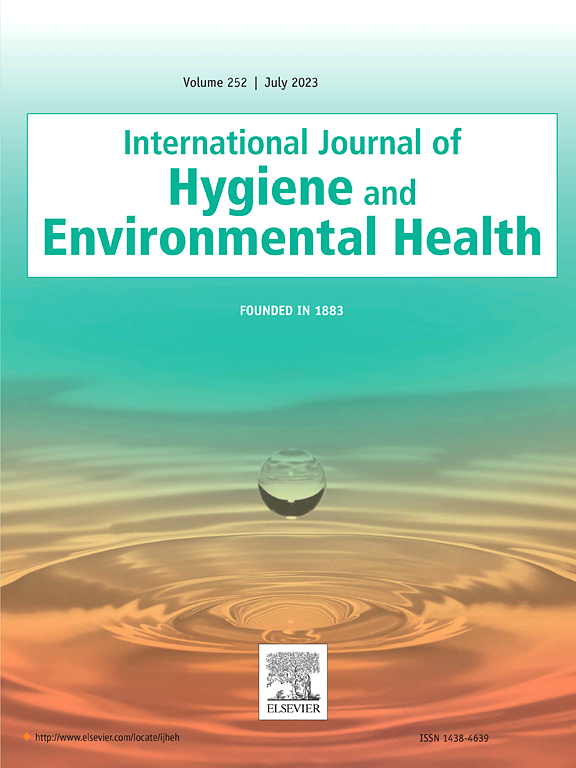产前接触全氟辛烷磺酸及其与儿童期神经行为和社会发育的关系
IF 4.5
2区 医学
Q1 INFECTIOUS DISEASES
International journal of hygiene and environmental health
Pub Date : 2024-09-25
DOI:10.1016/j.ijheh.2024.114469
引用次数: 0
摘要
接触全氟和多氟烷基物质(PFAS)无处不在,而且可能与神经发育毒性有关。然而,关于妊娠期接触 PFAS 对儿童神经行为损伤的风险,流行病学研究报告的结果不一。我们测量了来自加拿大母婴环境化学品研究(MIREC)的 757 名妇女的第一胎血液中全氟辛酸(PFOA)、全氟辛烷磺酸(PFOS)和全氟己烷磺酸(PFHxS)的血浆浓度。我们使用儿童行为评估系统-2 (BASC-2) 和社会反应量表-2 (SRS-2) 对 3-4 岁的儿童进行了评估(分别为 756 人和 496 人)。我们使用多变量线性回归法研究了个体和对数2转换后的PFAS总和与这些评估得分之间的关系。通过交互项和分层分析评估了性别对影响的修正作用。在男女混合样本中,母体全氟辛烷磺酸增加一倍与以下 SRS-2 量表的 T 分数降低显著相关:社会动机、DSM-社会沟通和SRS总分(B范围为-1.08至-0.78)的T值较低,表明暴露量越高,损伤越小。在性别分层分析中,在BASC-2的这些量表中,PFOA与男孩较低的T分数有关:行为症状指数、外化问题、攻击性和多动(B 范围为-1.32 至-1.03)。总之,在这一暴露水平较低的人群中,我们没有观察到产前暴露于所评估的全氟辛烷磺酸与儿童的神经行为和社会发展之间存在很强的关联。根据儿童的性别、神经发育结果和特定的全氟辛烷磺酸,结果显示出不同的结论。本文章由计算机程序翻译,如有差异,请以英文原文为准。
Prenatal exposure to PFAS and the association with neurobehavioral and social development during childhood
Exposure to per- and polyfluoroalkyl substances (PFAS) is ubiquitous and may be associated with neurodevelopmental toxicity. However, epidemiological studies report mixed results on the risks of gestational PFAS exposure for children's neurobehavioral impairment. We aimed to examine the associations between prenatal PFAS exposure and children's neurobehavioral and social problems.
We measured plasma concentrations of perfluorooctanoate (PFOA), perfluorooctane sulfonate (PFOS), and perfluorohexane sulphonate (PFHxS) in first-trimester blood from 757 women from the Canadian Maternal-Infant Research on Environmental Chemicals (MIREC) study. Children were assessed at 3–4 years with the Behavior Assessment System for Children-2 (BASC-2) and the Social Responsiveness Scale-2 (SRS-2) (n = 756 and 496, respectively). We used multivariable linear regression to examine associations between individual and summed log2-transformed PFAS and scores on these assessments. Effect modification by sex was evaluated through interaction terms and stratified analyses.
In the sample combining both sexes, a doubling of maternal PFOA was significantly associated with lower T-scores on the following SRS-2 scales: Social Motivation, DSM-Social Communication, and SRS Total score (B ranging from -1.08 to -0.78), suggesting lesser impairments with higher exposure. In sex-stratified analysis, PFOA was related to significantly lower T-scores in boys for these BASC-2 scales: Behavioral Symptoms Index, Externalizing Problems, Aggression, and Hyperactivity (B ranging from -1.32 to -1.03). In girls, however, PFAS were significantly associated more problem behaviors, but most associations were small and the CIs included the null, with the exception of PFOA being significantly associated with higher T-scores for the BASC-2Anxiety scale (B = 1.84, 95% CI: 0.36, 3.32).
In conclusion, we did not observe strong associations between prenatal exposure to the PFAS evaluated and children's neurobehavioral and social development in this population with low exposure levels. The results show mixed findings, depending on children's sex, neurodevelopmental outcome, and specific PFAS.
求助全文
通过发布文献求助,成功后即可免费获取论文全文。
去求助
来源期刊
CiteScore
11.50
自引率
5.00%
发文量
151
审稿时长
22 days
期刊介绍:
The International Journal of Hygiene and Environmental Health serves as a multidisciplinary forum for original reports on exposure assessment and the reactions to and consequences of human exposure to the biological, chemical, and physical environment. Research reports, short communications, reviews, scientific comments, technical notes, and editorials will be peer-reviewed before acceptance for publication. Priority will be given to articles on epidemiological aspects of environmental toxicology, health risk assessments, susceptible (sub) populations, sanitation and clean water, human biomonitoring, environmental medicine, and public health aspects of exposure-related outcomes.

 求助内容:
求助内容: 应助结果提醒方式:
应助结果提醒方式:


